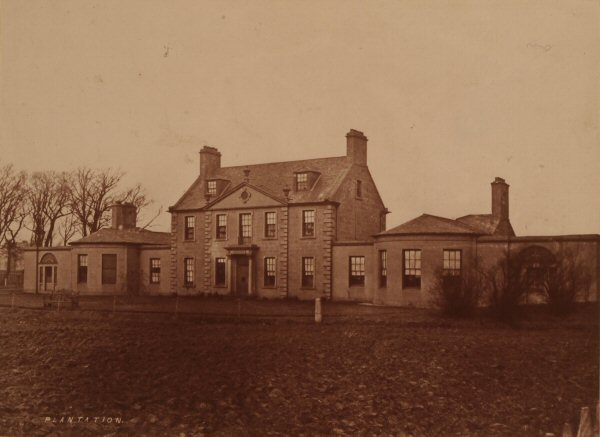

THE lands now called "Plantation," are situated about one mile west from Tradeston, near the toll bar where the roads diverge, leading to Govan, and to Paisley. They extend to about eighty acres, and are intersected by the two roads referred to. They are bounded on the north by the Clyde, on the south by the Paisley Canal, on the east by Park House, and on the west by Bellahouston and Haughhead. They are made up of three old properties - Craigiehall, Miln Park, and Sleads and Knolls.
In 1783 this property was purchased by John Robertson, merchant in Glasgow. There was then a small dwelling house upon it. Mr. Robertson was a well known citizen. He and his brothers were proprietors of several sugar and cotton plantations in the West Indies, and this induced him to change the name of the property from Craigiehall to that of "Plantation." Mr. Robertson was also many years cashier of "The Glasgow Arms Bank," originally composed of about thirty of the principal merchants in Glasgow, which began in 1750, and ceased in 1793. Mr. Robertson and his brothers were likewise partners in the lucrative business of "The Smithfield Company," for the manufacture of various articles of iron, such as nails, axes, spades, hoes, shovels, &c. This old company began in 1734, and was conducted by descendants of former partners down till within the last forty years. They had slitting rolling and grinding mills on the Kelvin, near the Point-house, and the present "Slit Mill" there derives its name from this old iron-work. They had also a cluster of houses at the "Point-house" mouth of the Kelvin, and established the ferry there across the Clyde. The warehouse was in a large edifice at the Broomielaw, a short way west from the Jamaica Street bridge. Robertson Street was carried through part of the property of these brothers Robertson, and is named after them.
In 1793 the property was sold to John Mair. He it was who, by lavish expense, made Plantation the beautiful residence it used to be. He enlarged and embellished the mansion, added wings and offices, built great walls and gates, and formed gardens and grounds not surpassed in their day in this quarter. Mr. Mair's history was a curious one. He was born in Paisley, and bred a mason. When working some height up Paisley steeple, he missed his footing, and was only saved by clutching a projecting stone. He managed to hold on by this till mattresses were hurried out to break his fall. But he had had enough of the mason trade. He left it and Paisley, and coming in to Glasgow, became a prosperous manufacturer here and in London, under the firm, which still goes on, of John Mair & Co. He had the stone that had stood him in such good stead brought to Plantation, and fixed in his grounds, and sacredly guarded. Beside it, in a sunny corner, he had an alcove built on the wall along the Govan Road : below was a seat : and here it was said he used to sit in thought. The top of the alcove, flanked by pinnacles, rose above the wall, and was a conspicuous object to the few passers by. The rumour ran in Govan parish that it surmounted the grave Mr. Mair was to lie in. But he lies in what was then the quiet country kirk-yard of Govan, with shady elms round it, and the clear river below. He died in 1824.
In 1829 Plantation was bought by William MacLean, dyer and manufacturer in Glasgow, and Deacon-Convener of that year. Mr. MacLean was afterwards Councillor and Bailie, and returning to the Council, after a long interval, served his native city again for several years, and only retired in 1864 when he was 81 years old. He died in 1867.
Since his death, the property which already, in his time, had been cut through by the railway to the south, and sliced away by the Clyde Trust to the north, has been entirely laid out for feuing, and in great part built over. And soon there will be little trace of its past history except in the names of some of the Streets, Mair and MacLean, Craigiehall and Plantation.
The house lot still belongs to Mr. MacLean's eldest son, William. The mansion house is standing, but one of the wings is gone, and the rest must soon follow. The alcove and seat, and the "Mair remembrance-stone" have been carefully removed and rebuilt by another of Mr. MacLean's sons on his property of Craigiehall, a few miles to the west of Plantation.
Back to Contents